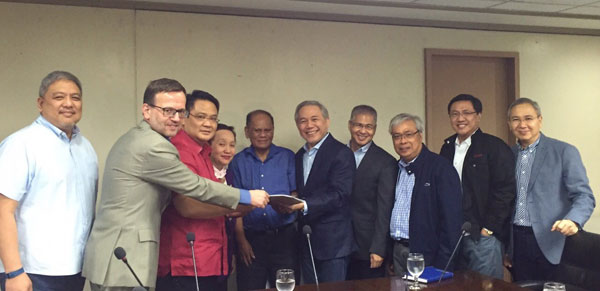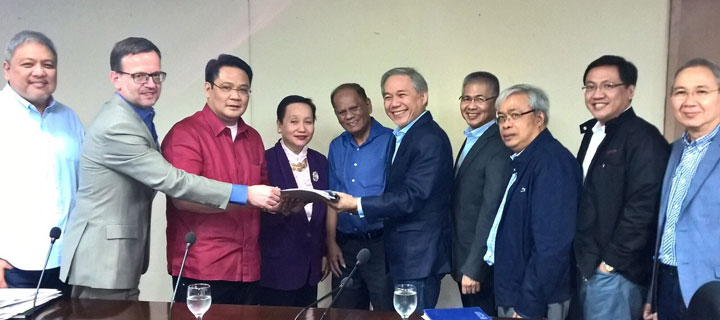- Telcos submit 3-year network rollout plan for 700 MHz and other frequencies shared with BellTel
- Smart to deploy LTE in nearly all cities and municipalities

In photo, PLDT Regulatory Head Ray Espinosa (6th from left) and PLDT-Smart Chief Technology and Information Advisor Joachim Horn (2nd from left) present copies of the plan to NTC Commissioner Gamaliel Cordoba (3rd from left). Also in photo are (from left): Smart Network Services Head Mar Tamayo, NTC Deputy Commissioners Delilah Deles and Edgardo Cabarios, Smart Legal and Regulatory Head Eric Español, PLDT’s Fred Carrera, Smart’s Roy Ibay, and PLDT Public Affairs Group Head Ramon Isberto.
Mobile leader Smart Communications (Smart) will cover 95% of the country’s cities and municipalities with its LTE (Long-Term Evolution) service by the end of 2018, according to the three-year roll-out plan submitted today by parent company PLDT to the National Telecommunications Commission (NTC).
According to the plan, Smart is rapidly expanding both the coverage and capacity of its LTE service, using its existing frequencies combined with the new spectrum that it had gained access to under the co-use arrangement between PLDT and the telecoms business of San Miguel Corporation (SMC). The submission of the three-year network rollout plan was one of the conditions imposed by the NTC in approving the frequency co-use arrangement between Smart and BellTel.
“We are accelerating our LTE deployment because this will enable us to deliver faster, more reliable and affordable Internet services throughout the country,” according to Joachim Horn, chief technology and information advisor at PLDT and Smart.
LTE, the fourth-generation (4G) mobile phone technology, is an all-IP (internet protocol) network that delivers a superior data service experience to customers compared to 3G technologies. It provides the fastest wireless data service commercially available, and is predicted by the recently released Ericsson Mobility Report of leading network vendor Ericsson, to be the dominant mobile access technology by 2019 worldwide.
This year, Smart is deploying the 700 MHz covered by the co-use arrangement, to roll out LTE in 360 cell sites in Metro Manila, Metro Cebu, and Metro Davao. Using the 700 MHz together with its existing frequencies, Smart will cover nearly 40% of the country’s 1,634 cities and municipalities by the end of 2016.
“Since its commercial launch in 2012, we have been deploying LTE in areas with high population concentration, where we have customers who have already purchased 4G/LTE handsets that can take advantage of the network and are using bandwidth-rich data services,” added Horn.
Under the new plan, Smart will deploy LTE to other key cities and major municipalities by 2017, and eventually cover 1,551 cities and municipalities by end-2018.
Complementing the LTE network deployment, Horn said Smart is also working with device manufacturers so that they can introduce more medium- to low-priced 4G or LTE handsets, tablets, and pocket WiFis that can run on multiple frequencies, to give more users access to the data network.
In the Smart network, almost 50% of the roughly 70 million Smart, TNT, and Sun subscribers are already using smartphones. The majority of these are 3G or HSPA+ handsets, but the number of 4G or LTE handsets is rising fast, as the range of available models increases and the handset prices decline.
“As more 4G or LTE device users access the internet, so will we see a surge in mobile data traffic,” added Horn.
The same Ericsson report shows mobile data traffic growing unabated worldwide, with the rise in both smartphone use and data consumption per subscriber cited as the drivers of growth.
“A critical component of this LTE rollout is the infrastructure that will support the increasingly large transport requirements of a network handling so much data traffic,” said Horn.
Smart expects that by the end of the three-year LTE network plan, it will have installed the necessary transport system to connect its nationwide base stations to the core network, along with international cable systems that provide massive capacity, and facilities that will allow local caching of content normally accessed by Filipino users.
“This is part of getting our network ready for the future, by putting in place the pipes that will accommodate the expected surge in data usage, and allow users to take advantage of speeds offered by next generation technologies such as LTE-A, and eventually 5G,” Horn added.
A part of Smart’s three-year plan presented to the NTC is its deployment of the next stage of development of LTE called LTE-A (LTE-Advanced), also referred to as 4.5G. Last April, Smart fired up the country’s first 4.5G service in the resort island of Boracay, using a feature of LTE-A called carrier aggregation, or combining two or more frequency bands to deliver bigger bandwidth to mobile phone users.
Smart’s drive to boost data coverage and capacity across the country forms a major part of the PLDT Group’s capital expenditure program. PLDT has set aside about P43 billion in total capex for 2016. It has allocated an additional US$100 million for to utilize the additional frequencies previously assigned to SMC.
Liked this post? Follow SwirlingOverCoffee on Facebook.


